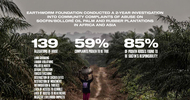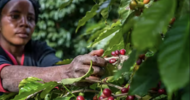Mongabay | 19 March 2019
Brazil’s key deforestation drivers: Pasture, cropland, land speculation
Brazil’s key deforestation drivers: Pasture, cropland, land speculation
by Alicia Prager
Brazil’s cropland (row crop) area nearly doubled between 2000 and 2014, new research from the University of Maryland’s Department of Geographical Sciences shows. This expansion is significant given that Brazil was already a major agricultural producer at the end of the 20th Century. In 2000, 26 million hectares (100,387 square miles) were used for cropland, that area grew to 46.5 million hectares (179,538 square miles) by 2014.
The study is the result of a deep dive into Brazil’s rich remote sensing knowledgebase. It combines various satellite monitoring at different resolutions to cross-check and validate results derived from the analysis of Landsat data – one of the world’s major satellite imagery archives. Researchers say that the new study shows that, using the many available data sets, it’s getting much easier to measure and forecast policy effects on deforestation, and to avoid errors.
The availability of accurate baseline data is particularly crucial today, as fears grow that deforestation rates will spike due to the expected deregulation of environmental protections under the rightest presidency of Jair Bolsonaro. “Satellite data allows us to monitor changes in the Earth’s cover, so whatever happens, we will know,” says Viviana Zalles, study lead author and a doctoral candidate at the Global Land Analysis and Discovery (GLAD) lab.
A key finding: most cropland is not created via the direct conversion of native vegetation. Rather it is established in a two-step process: forests are cut to create pasture; then those grazing lands are, over time, converted to croplands, especially soy. Of all existing Brazilian cropland, only 20 percent resulted from direct native vegetation conversion, while 80 percent was created from pastures.
At first, that might sound like good news, because pastureland “absorbs” cropland expansion, says Zalles. However, while the leading driver of deforestation is the creation of new pastures – and is the primary reason for tree cover loss in all forest types – the creation of cropland remains inextricably linked to the cattle industry, says Vivian Ribeiro, an Amazon Environmental Research Institute (IPAM) researcher currently preparing a study about this aspect of the conversion process.
Ribeiro underlines a very important point: the often speculative character of deforestation. Areas are claimed and deforested to make pastures, in the hope that the land once cleared and grazed can then quickly be sold at a highly inflated price to crop producers – especially the soy industry. Soy yields much higher profits from a piece of land than cattle ever can.
As a result, land speculation for both cattle and crops is a key deforestation driver. In Bahia state, for example, 15 percent of native vegetation deforested for pasture between 2012 and 2016, became cropland in less than five years, according to IPAM research. “Newly created pastures need around seven years to be profitable for the cattle ranchers, so we got suspicious,” of land converted to crops so quickly, she says.
“That gives a strong signal that the land has actually been cleared for speculative purposes,” agrees Tiago Reis, a PhD researcher on agricultural supply chains at Université Catholique de Louvain. He warns that it is very important to clearly differentiate between various groups within the agribusiness sector – a large part of the industry is working responsibly, and even strives for sustainable production. However, others are strongly associated with deforestation, land conflicts and speculation.
“With Bolsonaro’s election, the perception has spread that [producers] can do whatever they want. This effect of his presidency is problematic,” Reis says. In fact, during last year’s electoral campaign, Amazon deforestation rates shot up by nearly 50 percent as Bolsonaro’s electoral prospects improved, and possibly as ruralista land speculators anticipated policy changes under his new administration that would allow land grabbing with impunity.
Seeing the land with new eyes
“Improvements in remote sensing are mandatory to understanding [deforestation] problems in this country, and it is becoming more and more important to be able to understand the challenges for the future,” Ribeiro says.
Meanwhile, the remote sensing community is rapidly introducing new and better methods for mapping and estimating the extent of land use change. Zalles and her co-authors, for example, used robust statistical analyses to quantify cropland expansion. By providing more precise data, researchers hope to have greater influence on policy decisions.
Ribeiro emphasizes a key fact, one that is frequently raised by conservation NGOs. In truth, Brazil doesn’t need to deforest any more land in order to dramatically boost agricultural productivity. “Cattle and soy are very important for the economy, but the already cleared [agricultural] areas have a lot of potential to produce more intensively,” Ribeiro explains.
For instance, the average beef production in Brazil today is 50 kilograms (110 pounds) per hectare. However, the potential production on that same piece of ground using best ranching practices could rise to 300 kilograms (661 pounds) per hectare, says Daniel Silva, one of Ribeiro’s IPAM colleagues.
Intensifying cropland use would be much more challenging, Ribeiro says, which is why researchers like her suggest converting more of the already existing pastureland to soy. Brazil is already the world’s leading soy exporter; in 2018, it sold 83.8 million tons on global markets, a 23.1 percent rise over 2017. Thanks to China’s growing need for soy, and Donald Trump’s US/China trade war, Brazilian exports are expected to continue rising in future – production demand that could be met via pasture conversion without further deforestation.
However, for this to occur, a way must be found to curb the two-step land speculation process, whereby land speculators take over a piece of pristine forest, cut down and possibly sell the trees, put cattle on the land, then quickly sell to soy producers at a high price.
Deforestation shifts from the Amazon to the Cerrado
During the period covered by the study, the loss of natural vegetation in the Amazon slowed down significantly, while the rapid expansion of agribusiness shifted to the Cerrado, a vast savannah stretching east and south of the Brazilian Amazon.
The researchers found that the native vegetation conversion rate in the Cerrado biome was 2.5 times higher than in the Amazon, almost certainly because protection policies are much looser there under Brazil’s Forest Code, with Cerrado soy producers also not limited by voluntary deforestation agreements such as the Amazon Soy Moratorium (ASM).
The Cerrado, and especially Matopiba (comprised of the Cerrado states of Maranhão, Tocantins, Piauí and Bahia), is often called Brazil’s agricultural frontier because of the ease with which the region’s rich soils, and rolling-to-flat landscape, can be readily exploited by mechanized agribusiness.
After Brazil’s nationwide agricultural expansion peaked in 2004, it slowed down drastically, with a low point in 2012. And while the native vegetation conversion rates rose drastically again since in many areas, such as the Cerrado, deforestation in the Amazon remained low, especially after 2006 when the ASM was instituted. However, Amazon deforestation has risen again in the last few years.
Zalles credits the 2006-2013 Amazon deforestation declines to the ASM – an agreement between commodities traders, conservation NGOs and government to not source soy from newly deforested lands. “If it wasn’t for the moratorium, it is possible that the deforestation rates would have gone up again in the Amazon as well,” Zalles says. A look at the study’s data analysis shows a correlation between the ASM’s implementation in 2006 and a steep decrease in native vegetation conversion directly due to new soy production in Amazonia.
A similar agreement in the Cerrado, such as that promised by the embryonic Cerrado Manifesto, could be a good step forward, says Matthew Hansen, co-director of GLAD, who supervises Zalles’ research. “We need to keep pushing deforestation rates down, but that’s not what is currently happening. And with the new [Bolsonaro] administration, current geopolitical development, diet changes [as people consume more meat and soy], and population growth, I think there will be more cropland expansion in natural areas,” he adds, noting the recent upward trend in land conversion.
Of course, Brazil will continue to play a major role in providing a hungry world with food. So finding innovative ways to increase productivity on already deforested land will be key, and will become increasingly urgent, if the country’s biodiversity-rich ecosystems are to be conserved.
In a next step, the University of Maryland research team plans a similar, but far broader, study of land use change as it looks at all of South America since 1985. This time, they research group will map soy as a class by itself in order to understand the commodity’s broader environmental impacts on the continent.
Citation:
Viviana Zalles, Matthew C. Hansen, Peter V. Potapov, Stephen V. Stehman, Alexandra Tyukavina, Amy Pickens, Xiao-Peng Song, Bernard Adusei, Chima Okpa, Ricardo Aguilar, Nicholas John, and Selena Chavez. Near doubling of Brazil’s intensive row crop area since 2000. By Proceedings of the National Academy of Sciences Jan 2019, 116 (2) 428-435; DOI: 10.1073/pnas.1810301115













